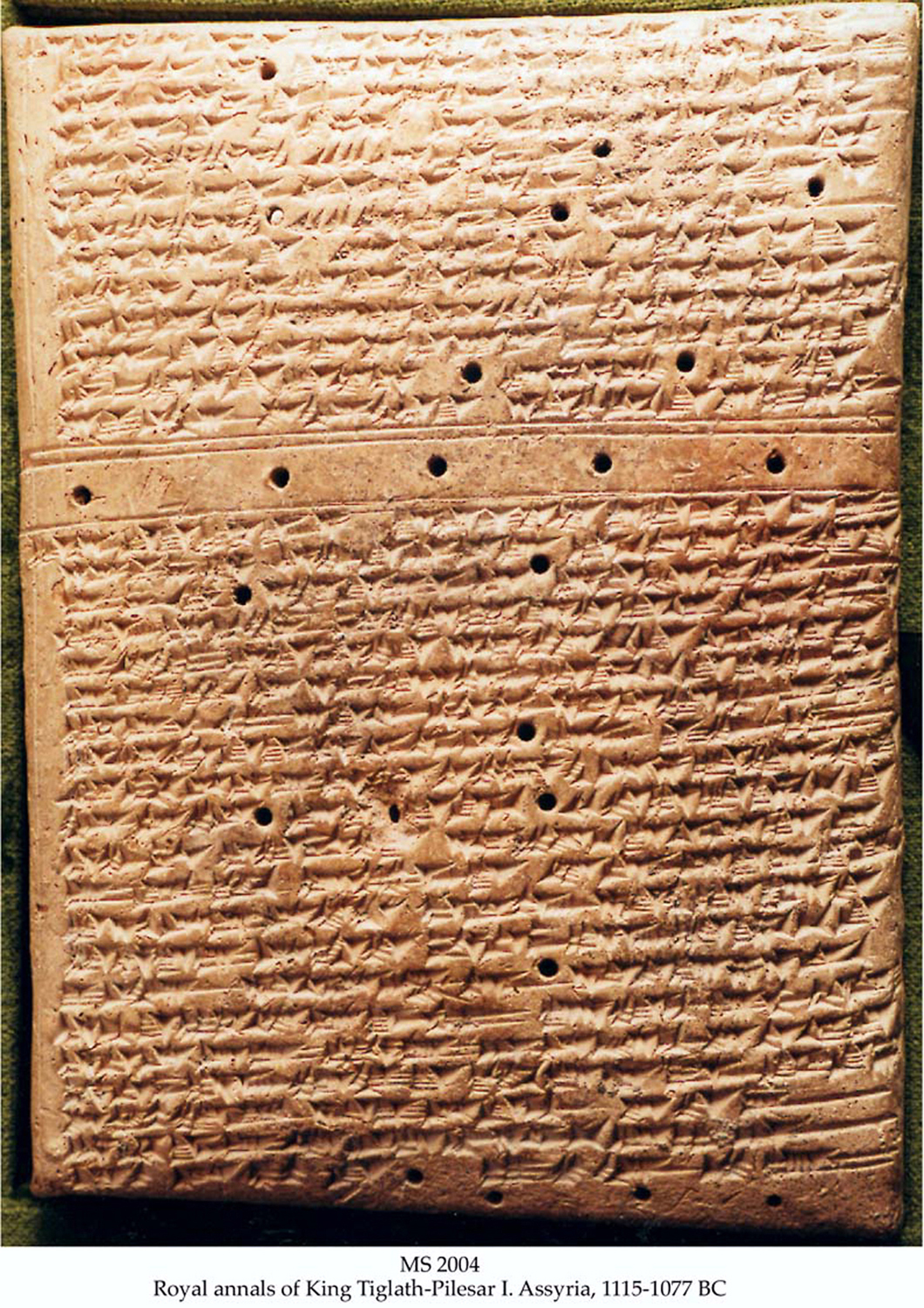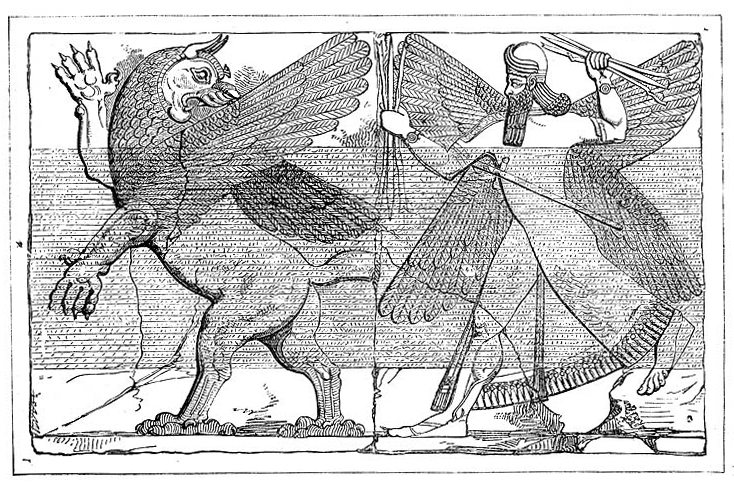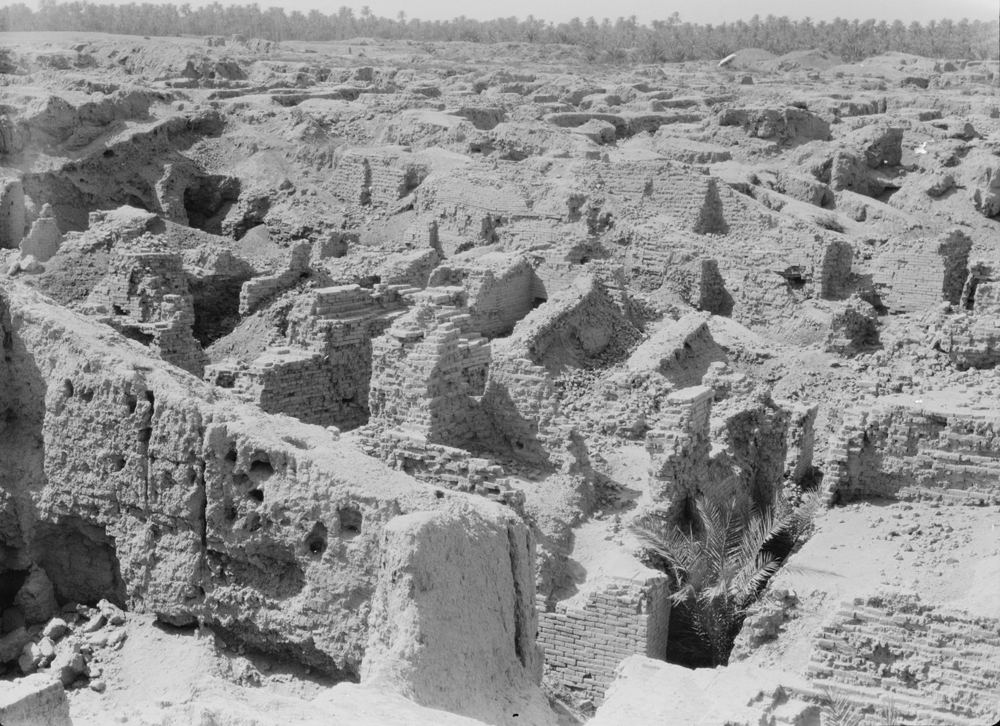What Impact Did Nebuchadnezzar Have on Baby Lion
Ancient Babylon: Center of Mesopotamian Civilization

Located about 60 miles (100 kilometers) south of Baghdad in modern-day Iraq, the aboriginal city of Babylon served for nearly two millennia every bit a center of Mesopotamian civilization.
I of its early on rulers, Hammurabi, created a harsh system of laws, while in afterward times the Babylonian language would be used beyond the Middle Eastward as a way of communicating across borders. Some other great accomplishment, if the ancient stories are true, is the construction of the Hanging Gardens, a wonder of the aboriginal world, which some believe was congenital by the biblical king Nebuchadnezzar Two.
The aboriginal scientists who lived in the city made important discoveries in mathematics, physics and astronomy. Amid their many accomplishments, they developed trigonometry, used mathematical models to track the planet Jupiter and adult methods of tracking fourth dimension that are still used today. Aboriginal Babylonian records are still used by modern-24-hour interval astronomers to written report how the rotation of the Earth has changed.
"Babylon, in all its manifestations, is at once remote to united states and all around u.s.. Similar no other urban center, its history has go bound upward with legend..." write researchers Irving Finkel and Michael Seymour in the volume "Babylon" (Oxford University Press, 2008).
Early on beginnings
The area that Babylon is located in is "subject to very high temperatures and lies well across the reach of rain-fed agriculture," writes Michael Seymour, a inquiry associate at the Metropolitan Museum of Art, in his book "Legend, History and the Ancient City of Babylon" (I.B. Tauris, 2014). He notes that an irrigation organization that distributed water from the Euphrates and Tigris rivers had to be used to grow crops. "Once established, however, such a system could reap the benefit of rich alluvial soils and support extremely productive agronomics on the levees of canals."

Archaeologically, little is known about the early history of Babylon. Ancient records suggest that more than 4,000 years ago, at a time when the city of Ur was the middle of an empire, Babylon appears to have been a provincial administration center. "Babylon had not been an independent city," writes researcher Gwendolyn Leick in her book "The Babylonians" (Routledge, 2003).
She notes that in 1894 B.C., afterward the Ur-based empire had collapsed, the metropolis was conquered past a man named Samu-abum. He was an Amorite, a Semitic-speaking people from the area effectually modern-day Syria. He proceeded to turn Babylon into a picayune kingdom made upward of the metropolis and a small amount of nearby territory. Babylon would remain this mode until, six kings later, a man named Hammurabi (1792-1750 B.C.) ascended the throne. He was the ruler who would go on to plough this once small kingdom into a great empire.
The empire of Hammurabi
Leick notes that Hammurabi had to be patient before he could aggrandize. Located between 2 larger kingdoms at Larsa and Ashur, he was cautious. He used his time wisely. "At abode he concentrated on improving the economic basis of his kingdom by building canals and strengthening fortifications," she writes.
With the expiry of the king of Ashur, and the power vacuum resulting from it, Hammurabi was able to expand. After a series of campaigns, he defeated Rim-Sin, the ruler of Larsa, a man who had ruled a big kingdom for virtually 60 years. "This victory signalled the annexation of all the old urban centers, such equally Ur, Uruk, Isin and Larsa," Leick writes. Further campaigns against Assyria and Mari further expanded Hammurabi'south empire.
Archaeologists know fiddling almost what Babylon itself looked like during Hammurabi'due south reign. "The remains of Hammurabi'south own metropolis at Babylon are, unfortunately, virtually inaccessible as the water table has risen also high to allow them to be explored," writes researcher Harriet Crawford in a paper published in the book "The Babylonian World" (Routledge, 2007).
While archaeological remains are scarce, textual remains are more than illuminating. Leick writes that Hammurabi's stature was such that he became regarded as a god. She notes that parents gave their children names that meant "Hammurabi is my help" or "Hammurabi is my god."
Hammurabi himself would discuss the nature of his divinity in his famous law code.
Law Lawmaking of Hammurabi
While the Law Code of Hammurabi (at present in the Louvre) is well known for its "eye for an eye" style of lawmaking, it also sets out the nature of the relationship between Hammurabi, the gods and the people he ruled.
In his view, the gods sent him to rule, with some level of pity, over his empire. The preamble to the code says that "so Anu and Bel [both gods] called by proper name me, Hammurabi, the exalted prince, who feared God, to bring near the rule of righteousness in the country, to destroy the wicked and the evil-doers; so that the strong should non impairment the weak ..." (Translation past Fifty.W. Male monarch)
While Hammurabi claimed to be compassionate, his code was harsh, making liberal use of death sentences (in some cases fifty-fifty for stealing) and allowing the hacking off of body parts. This is a change from an earlier law lawmaking, created centuries ago past a ruler of Ur, which was more inclined to impose fines.
Leick as well notes that debt slavery was a problem, and Hammurabi, and later his successors, had to occasionally cancel debts. These acts "hint at a less rosy picture of crushing debt burdens incurred through falling agricultural productivity and high interest rate on loan capital letter taken out to run across tax demands and other obligations."
Women did not always receive equal treatment under Hammurabi's lawmaking. I constabulary reads, "if a finger has been pointed at a man's wife because of some male but she has non been defenseless copulating with another male, she shall spring into the River for the sake of her husband," (translation past H. Dieter Viel).
However, the code did have rules that protected woman who had to live with another man because their hubby had been captured in war. There were also rules that stipulated that a widowed woman should receive an inheritance and that an unmarried woman should receive financial back up from her brothers after the death of her father.
Kassite period
Ultimately, Hammurabi'southward empire was not to final, falling into decline after his decease. In 1595 B.C., the Hittite ruler Mursili I captured Babylon, bringing the rule of Hammurabi's successors to a close. Researcher Susanne Paulus notes in a 2011 paper published in the journal Beihefte zur Zeitschrift für Altorientalische und Biblische Rechtsgeschichte (Supplements to the Journal of Ancient Most Eastern and Biblical Legal History) that, adding insult to injury, the Hittites seized the statue of Marduk, who had become a primary god of the Babylonians.
In the chaos that followed these events, a people chosen the Kassites (also known as the galzu) came to power in Babylon. They had access to adept horses, giving them a armed services reward.
They announced to accept made an endeavour to win over the people of Babylon, "they brought dorsum the statue of the major deity, Marduk, which had been stolen by the Hittites, and restored his cult in Babylon" Paulus writes. "The Kassite kings restored the temples of the Babylonian gods, while their own pantheon had fiddling influence."
Leick notes that Kassite dominion "brought five hundred years of stability, prosperity and peace" to Babylon.
While Babylonian writing may have go more professionalized and exclusive during this menstruum (Leick notes there appear to have been far fewer personal messages written) the language itself became widely used beyond the Heart East.
Information technology turned into a "lingua franca for the whole Near East from the fifteenth to the cease of the thirteenth century," Leick writes. Babylonian works could exist constitute in Turkey, Syria, the Levant and Arab republic of egypt, as well equally Mesopotamia. "Babylonian scribes were very much in demand at strange courts ..."

Wars with Assyria and Elam
The period from roughly 1200 to 600 B.C. would be a rocky 1 for Babylon, 1 filled with many wars and some successes. Around 1200 B.C., the whole eastern Mediterranean suffered calamity as a wave of migrants called the "Bounding main People," maybe spurred on by crop failures and environmental problems, swept over much of the Middle East, felling cities in Turkey and the Levant and contributing to problems that would see the break-up of Egypt.
Babylon suffered equally well. A state of war with Assyria resulted in a Babylonian male monarch existence led to Ashur in bondage while one with Elam led to the statue of Marduk beingness stolen yet again. A new Babylonian ruler named Nebuchadnezzar I (1126-1105 B.C.) came to the rescue, so to speak, defeating Elam and bringing the statue back. Leick writes that with his success, the New Yr festival became increasingly of import.
"This complex ritual, which involved the gathering of all important Babylonian deities at Babylon, the recitation of the Creation Epic (enuma elish) and the confirmation of kingship by the god Marduk, was given new impetus, if it was non altogether invented at this fourth dimension," she writes.
Babylon struggled over the following centuries, and the Assyrians would invade once more. Leick notes that the city was put nether straight Assyrian dominion from 729-627 B.C. and during a rebellion in 689 B.C. was said to have actually been flooded, with the statues of its gods seized or destroyed by the Assyrians. It would take a war waged by a king named Nabopolassar (allied with an Iranian people chosen the Medians) to gratuitous Babylon and eventually conquer the Assyrian capital at Nineveh in 612 B.C.
Out of Nabopolassar'due south efforts a new golden age would emerge for Babylon. In 605 B.C., Nebuchadnezzar 2, of biblical fame, would take over, and he was at present in a position to build an empire.
Nebuchadnezzar 2'southward Babylon
Through military conquests, Nebuchadnezzar Two would come up to dominion an empire that stretched from the Persian Gulf to the borders of Egypt. He captured Jerusalem twice, in 597 B.C. and 587 B.C., events that led to the destruction of the first temple, the deportation of many Jewish inhabitants to Babylonia and the capture of the Ark of the Covenant.
At Babylon itself, he began a major building and reconstruction plan, the metropolis having an inner and outer wall. "Babylon reached its greatest glory equally a city during the reign of Nebuchadnezzar II," writes University of London professor Andrew George in a chapter of the book "Babylon." Religion played a key role. "At its heart were fourteen different sanctuaries, and some other twenty-ix were distributed throughout the residue of the urban center. That was quite apart from the hundreds of street site chapels and shrines."
One of the biggest shrines was named Esagil, defended to Marduk. Located due south of a peachy ziggurat, George says it 280 feet (86 meters) by 260 anxiety (79 m) in size with gateways thirty feet (nine m) loftier. "Nebuchadnezzar lavished attending on the cult-rooms: at that place were gold, silver and gemstones everywhere..."
Palaces
Nebuchadnezzar Two'due south city would have no less than three major palaces. The southern palace was 1,065 feet (325 k) by 720 feet (220 one thousand) in size. It included a throne room with a glazed brick panel showing palmettes, floral reliefs and lions. The tiles were glazed in blueish and yellowish, something common among the near important structures in Nebuchadnezzar II's Babylon.
The king also had a northern palace (which hasn't been fully excavated) and a summer palace, on the northern tip of the outer wall. It was "for use in summer when the metropolis air was stifling and its smells at their worst," writes George.
Ishtar Gate
Built past Nebuchadnezzar Two and named afterwards Ishtar, a goddess of beloved and war, the Ishtar Gate served every bit the ceremonial archway to the inner wall of Babylon, a road that ultimately leads to the ziggurat and Esagil shrine. People passing by information technology in antiquity would see glazed blue and yellow bricks with alternating images of dragons and bulls carved in relief. A reconstruction of it that incorporates surviving materials is currently in the Staatliche Museen zu Berlin Vorderasiatisches Museum in Frg.
Joachim Marzahn writes in a chapter of "Babylon" that the "amazing Ishtar Gate, equanimous of an ante-gate in the outer wall and the main gate in the larger inner wall of the city, with a 48 meter-long (158 feet) passage, was decorated with no fewer than 575 depictions of animals (co-ordinate to calculations made by excavators)," noting that these "pictures, of bulls and dragons, representing the holy animals of the weather god Adad and the majestic god Marduk, were placed in alternating rows."
In addition, Marzahn writes that a processional way ran through the Ishtar Gate, and for about 590 feet (180 yard) had images of lions carved in relief. The mouths of the lions are open up, baring their teeth, and the manes of the creatures are finely detailed.
Every leap the male monarch, his courtiers, priests and statues of the gods traveled along the processional way, traveling to the Akitu Temple to celebrate the New year festival.
"The dazzling procession of the gods and goddesses, dressed in their finest seasonal attire, atop their bejeweled chariots began at the Kasikilla, the master gate of the Esagila (a temple dedicated to Marduk), and proceeded north forth Marduk'due south processional street through the Ishtar Gate," writes Julye Bidmead, a professor at Chapman University, in her book "The Akitu Festival: Religious Continuity and Royal Legitimation in Mesopotamia" (Gorgias Printing, 2004).
The Tower of Babel?
Although largely destroyed today, in ancient times the ziggurat of Etemenanki (whose proper name means roughly the "Temple Foundation of Heaven and Earth") would accept towered over the urban center, located just to the north of the Esagil shrine. Like the shrine, information technology was defended to the god Marduk.
The Greek author Herodotus, who lived in the fifth century B.C., describes it as a "solid belfry" which is "two hundred and xx yards long and wide; a second tower rises from this and from information technology yet another, until at last there are viii ..."
He says that "in the final tower there is a smashing shrine; and in information technology stands a not bad and well-covered burrow, and a gilt tabular array nearby. Simply no image has been set up in the shrine, nor does whatsoever human creature prevarication there for the night, except one native adult female, called from all women past the god, as the Chaldaeans say, who are priests of this god." (Translation by A.D Godley, through Perseus Digital Library)
Herodotus may take exaggerated its size somewhat with modernistic-day scholars believing that it rises upwardly seven rather than viii levels. Besides Herodotus believed it was dedicated to the god Bel rather than Marduk.
However, rebuilding the construction would have been an impressive feat and, as some scholars believe, may take inspired the biblical story of the Tower of Babel. The story reads in Genesis:
Now the whole world had one language and a common voice communication. Every bit people moved eastward, they constitute a plain in Shinar and settled there. They said to each other, "Come, allow's make bricks and bake them thoroughly."
They used brick instead of stone, and tar for mortar. So they said, "Come, allow united states of america build ourselves a city, with a belfry that reaches to the heavens, so that we may brand a name for ourselves; otherwise we will be scattered over the confront of the whole earth."
But the Lord came down to run across the city and the tower the people were building. The Lord said, "If equally one people speaking the same linguistic communication they have begun to do this, then nix they plan to exercise will exist impossible for them. Come, let us go down and confuse their linguistic communication so they will not empathise each other."
So the Lord scattered them from at that place over all the earth, and they stopped building the city. That is why it was called Babel — because in that location the Lord confused the language of the whole world. From there the Lord scattered them over the face of the whole world. (Genesis 11:1-9, NIV)
In 2011, an ancient stele with an image of Nebuchadnezzar Ii was formally published. In it the king is shown standing beside the ziggurat. The artifact has been given the name "The Tower of Babel Stele."
Hanging Gardens
Scholars do not know where the Hanging Gardens were in Babylon, or even if they really existed, but ancient writers described them in detail. The gardens are considered to be one of the 7 wonders of the ancient globe.
Philo of Byzantium writes (around 250 BC) that:
"The Hanging Gardens [is so-called because it] has plants cultivated at a height above ground level, and the roots of the trees are embedded in an upper terrace rather than in the earth. This is the technique of its construction. The whole mass is supported on stone columns, so that the entire underlying space is occupied by carved cavalcade bases ..." (Translation by Professor David Oates)
Another, later, account is by Diodorus Siculus (showtime century B.C.). He writes that the Hanging Gardens were built "past a afterward Syrian king to please i of his concubines; for she, they say, existence a Persian by race and longing for the meadows of her mountains, asked the king to imitate, through the artifice of a planted garden, the distinctive landscape of Persia."
Modern-day scholars take noted that Herodotus, who lived earlier than Philo, does non mention the Hanging Gardens. There are also no known Babylonian records of the site.

Loss of independence and ruin
Ultimately, Nebuchadnezzar II'due south empire would not final much longer than the ane congenital past Hammurabi. In the 6th century B.C., the Achaemenid (Persian) empire would ascension to the east, a kingdom so powerful that information technology would i day try to invade territories equally far west as Greece.
Leick notes that on October. 29, 539 B.C., Babylon fell to Cyrus the Nifty, the legendary Persian leader. Nabonidus, the last king of independent Babylonia was taken to Iran to live out the rest of his life in exile. Cyrus claims that his troops faced no resistance when he took Babylon in an ancient inscription which is at present in the British Museum and called the "Cyrus Cylinder." Cyrus claimed that "I went as straw of peace into Babylon," Cyrus claimed (translation by Irving Finkel) and that he "I founded my sovereign residence inside the palace among celebration and rejoicing."
If there was a warm welcome for the Persians it didn't last. In 528–526 B.C., Babylon and the area effectually information technology was hit by a famine that was brought virtually by the failure of barley crops, said Kristin Kleber, a lecturer at Vrije Universiteit Amsterdam, in a paper published in 2012 in the journal Zeitschrift für Assyriologie und vorderasiatische Archäologie. The workers "who rebuilt the metropolis wall of Babylon in the years 528–526 B.C. must have felt as though they were in the antechamber of hell," writes Kleber, noting that ancient texts mention discontent amid the Babylonians.
Still Babylon would never exist independent over again. The side by side millennia would run across the urban center fall under the sway of several different empires, including that of Alexander the Great (who died in Babylon in 323 B.C.), the Seleucids, the Parthians and even the Romans. In the finish, information technology would be "buried under the sands" Leick writes, forth with many other ancient Mesopotamian cities.
Modernistic day
"Nigh of the city was rebuilt past Saddam in the mid to late 1980s to recreate it every bit it was in the era of King Nebuchadnezzar, 600 B.C.," writes journalist Robert Galbraith in his book "Iraq: Bystander to War - A Photojournalist's Diary" (self-published, 2004). Galbraith reported from Republic of iraq after the 2003 U.Due south. invasion and visited Babylon presently afterwards the U.S. occupation of Iraq began. Galbraith notes that around the time of the invasion the ancient urban center was looted and a group of U.South. Marines were eventually assigned to guard the site.
Saddam Hussein had constructed a palace at Babylon that "looms over the metropolis" but "is strikingly out of identify," writes Galbraith. "It is a cute finely carved sandstone castle, and looks similar an Arabian palace. But that's the trouble; information technology is obtrusive, misplaced and tacky to the limit. It appears that Saddam tried to buy his manner into the history books by edifice his monument overlooking the aboriginal metropolis," writes Galbraith.
Babylon would be turned into a U.S. military base. While this deterred some annexation it caused damage to the ancient urban center and left more mod remains (including a basketball hoop) at the site that had to be cleaned up. Afterward U.S. forces left, some cleanup and conservation work was done and the ancient city has been re-opened for tourists. In 2010 the U.S. government announced that information technology would spend $ii million to conserve Babylon's Ishtar Gate.
Groundwater has been a problem at Babylon and a proposal to use underground dams to lower and control groundwater at the site was published in 2015 by a team of scientists from the Academy of Babylon, in Iraq, in the "International Periodical of Civil Engineering science and Technology."
ISIL forces failed to accomplish Babylon during their 2014 offensive and, as such, the city was spared the devastation that befell other ancient sites occupied by the terrorist grouping.
Additional resources
- National Geographic: Beautiful Babylon: Jewel of the Ancient World
- The Guardian: Babylon — how war nigh erased 'flesh's greatest heritage site'
- Bible Atlas: Babylon
Source: https://www.livescience.com/28701-ancient-babylon-center-of-mesopotamian-civilization.html

0 Response to "What Impact Did Nebuchadnezzar Have on Baby Lion"
Postar um comentário